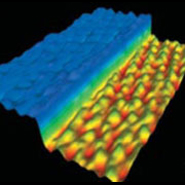Posted: 20 July 2007
Leading nanotechnology research group joins UCD
Professor Suzi Jarvis and her multidisciplinary research team, the Nanoscale Function Group, who investigate the function of organic and biological molecules on a nanometer scale, have joined the UCD Conway Institute. Through its research, the group aims to build the foundations for future nanotechnology and biotechnology.
“Using Atomic Force Microscopy (AFM) we effectively ‘feel’ the individual molecular building blocks that constitute biological membranes. These membranes make up the cell wall, and our group hopes to understand how they mediate drugs and viruses entering cells,” said Professor Jarvis.
“Water and ions are always present when these processes occur but no one is quite sure whether or how they influence what happens. Our group can visualize directly what the water and ions are doing next to these membranes, providing the first real insight into these processes at the nanometer scale.”
AFM uses a sharp probe under controlled conditions to build a 3-dimensional image of a sample. Frequency modulation AFM (FM-AFM) is an extension of the technique for extra sensitive measurements that is used extensively in ultra-high vacuum. Professor Jarvis pioneered the implementation of this technique in liquid, allowing for the technique to be used for the study of biological materials under physiological conditions.
Amyloid fibrils, long fibers that self-assemble from misfolded proteins, have long been associated with a range a debilitating and incurable human diseases. The Nanoscale Function Group has identified amyloid structures in the natural glues produced by five species of algae and an invertebrate organism suggesting that physiological amyloid is in widespread use in natural materials.
“Using AFM to pull apart individual amyloid fibrils we have managed to explain why nature uses these structures to add mechanical strength to her materials” said Professor Jarvis. ”We are now seeking to understand the self-assembly process of these protein structures to identify the triggers for amyloid formation in a range of physiological and pathogenic contexts.”
The Nanoscale Function Group is a multidisciplinary team drawn from a diverse skill base including: physics, electrical and mechanical engineering, materials science, mathematics, chemistry, biology and phycology.
Professor Jarvis graduated from the University of Oxford with a BA in Physics and a Kodak sponsored DPhil in Materials, followed by postdoctoral fellowships in Japan at the Joint Research Center for Atom Technology, Tsukuba. Then she took up a staff post at the Nanotechnology Research Institute, Tsukuba. In July 2002, she became a Science Foundation Ireland principal investigator at Trinity College Dublin.
The group has a number of national and international collaborations. Professor Jarvis, a co-founder of the International Nanotribology Forum, has made invited contributions to Nanosurface Chemistry, Encyclopedia of Chemical Physics and Physical Chemistry and Applied
Scanning
Probe Methods VIII. She has 50 publications in
journals spanning a number of disciplines including Nature, Physical Review Letters, Chemical Physics Letters, Biophysical Journal, Nanotechnology and Review of Scientific Instruments.

